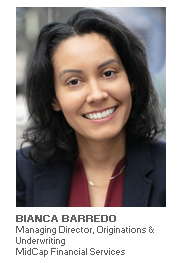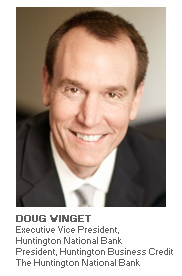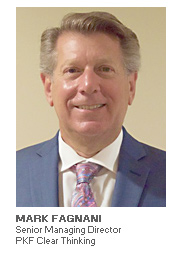
In this new ABL Advisor feature article series, Charlie Perer, of SG Credit Partners, meets with commercial finance industry participants to discuss the state of the asset-based lending (ABL) industry and general market dynamics. The purpose of this series is to hear from a group of leaders who cover the spectrum of lending, turnaround advising and capital raising to hear their views and how they are positioning their businesses in the current environment.
Here to tell the story are Doug Winget of Huntington Business Credit, Bianca Barredo of MidCap Financial, Mark Seigel of Crown Partners and Mark Fagnani of PKF Clear Thinking.
Charlie Perer: Please briefly introduce yourselves and tell us a bit about your business.
Doug Winget: I am President of Huntington Business Credit (HBC), the Asset Based Lending Group of Huntington National Bank. HBC is focused on ABL financing opportunities spanning the middle market and large corporate markets. HBC has vertical specialties within ABL retail and ABL metals.
Bianca Barredo: I am Managing Director of MidCap Financial’s ABL Group where I lead a team focused on originating and underwriting ABL stretch products, which include first out facilities, Revolver + FILOs, enterprise term loans and cash flow tranches.
Mark Seigel: I am Co-Founder and Managing Partner of Crown Partners, a capital markets advisor focused exclusively on the asset-based lending market. We arrange senior credit facilities for middle-market companies seeking to maximize their liquidity and financial flexibility, and we advise specialty finance companies on their strategic plan and capital structure.
Mark Fagnani: I’m Senior Managing Director of PKF Clear Thinking, a turnaround, restructuring and advisory firm.
Perer: How would you describe the current market environment through the lens of your own business?

Barredo: Quite unpredictable. Volume is robust and there are a number of interesting opportunities for ABL stretch driven by the leverage loan market pulling back, FILO lenders pushing for first dollar at their relatively higher cost of capital and regional banks retrenching on certain strategies. This capital markets uncertainty leads sponsors and advisors to go wider in their search for financing which has created opportunities to provide solutions-oriented structuring. But, as a lender, the competitive landscape is tough to predict and uncertainty in the general economy makes it challenging for investment committees. Against this backdrop, lenders are leaning into specific, higher conviction opportunities.
Seigel: The ABL market is functioning efficiently with both banks and non-bank ABL lenders actively pursuing new financing opportunities – stretching less than previously on structure and opening liquidity. A consistent theme in the non-bank market is groups are curtailing their maximum hold sizes – increasing their reliance on pre-close syndication. Frequently, the top 4 to 7 players are clubbing on transactions. Outside of one or two names, any transaction over $75 million is being pre-close syndicated.
Winget: The ABL market slowed in 2Q 2023 subsequent to the bank failures at the end Q1, as companies became cautious bringing new opportunities to market or amend/extend. However, we have recently seen an uptick in the ABL financing market opportunities over the last month, as companies have made the decision to move forward with strategic initiatives and financings.
Fagnani: On the one hand, our firm has gotten much busier as have many of our competitors, the size of loans with issues has increased and the nature of the problems we are seeing are more complex than in the recent past. Most lenders are reporting an uptick in their problem loans or accounts on their “watch list.” In addition, bankruptcy filings are on the rise. On the other hand, many lenders report that their loan portfolios continue to perform very well. This is somewhat surprising given inflationary pressures, rising interest rates and a perceived change in lender risk appetite as a result primarily of the recent bank failures. We have seen an uptick in refinancing activity, and I think this is primarily driven by the aforementioned change in risk appetite.
Perer: What will be the lasting effects from the most recent regional banking crisis?
Barredo:Widely syndicated bank deals will be tougher to place for a while and I am seeing more hung bank syndications. Capital is precious to regional banks so deploying it in widely syndicated deals with no cross sell is much less interesting. We are generating deal flow for $150 million plus facility requests with Borrowers’ willing to pay a premium for a single lender and money centers are calling for $30 to 50 million allocations in deals they are unable to place. We believe this type of environment will continue for the next couple of years.

Seigel: Non-banks will continue to increase their market share. Already, in recent months large credit managers such as KKR, Carlyle, Angelo Gordon and Comvest have announced new $1 billion plus funds, which as those managers state in their marketing materials, are meant to fill the gap in bank lending capacity. Among regional banks, there will be less appetite to remain as non-agent co-lender in transactions for which there is no treasury management opportunity.
Winget: Banks (and subsequently ABL groups within banks) have become more focused on capital ratios and thus pricing and the appropriate ROE of their portfolio credit facilities.
Fagnani: As noted above, we have seen some banks take a more conservative approach to risk and portfolio growth in recent months. It is not clear that this will be a long-term situation. Banks have notoriously short memories and love growth. I think a more lasting effect will be a more disciplined approach to deposit taking focused on consumer versus commercial deposit percentages, more focus on levels of uninsured deposits (i.e., over $250,000) as a percentage of total, avoidance of extreme concentrations and an extreme focus on capital levels. This may have an indirect impact on lending activities for some banks as limited available capital should be allocated to those products that provide the greatest yield.
Perer: Have banks finally shifted to a risk-off mode that should benefit the ABL market?
Barredo: I’ve been calling it the tale of two banks. It seems like on one side you have banks that are risk-off and worried about capital ratios. They seem to be running off loans and not actively pursuing new opportunities. On the other hand, you have other banks that are looking at this as an opportunity to grab market share and even get some yield out of their loans.
Seigel: There has been a more active pipeline for asset-based lending because more middle-market companies are focused on bolstering their liquidity now that the government stimulus era is over. Companies that currently are borrowing within bank C&I groups – which are EBITDA and fixed charge covenant driven – are not in a position to access greater proceeds and are therefore more interested in asset-based solutions.
Winget: Given banks’ heightened focus on ROE and capital ratios, I do believe a risk-off period will result and benefit the ABL market.
Fagnani: We have seen this “de-risking” activity from a few banks, but I would not describe it as widespread. Some of our non-bank referral sources have reported more incoming requests for financing from borrowers being pushed out of banks (some gently, some shoved), but I think it would be premature to describe that as an industry-wide occurrence.
Perer: Where is deal flow both in terms of quality and quantity compared to this time last year?
Seigel: There is a greater number of opportunities in pipeline, with opportunities being “harder” in terms of the pieces that need to come together in order to be successful.
Barredo:We’ve seen deal flow pick up moderately as advisors, companies and sponsors are casting a wider net for debt reads and term sheets. That dynamic is keeping pipelines robust at non-banks and there are definitely interesting opportunities to pursue. However, I see two problems. One is that there are fewer high-quality deals, so you have more lenders aggressively chasing a smaller subsegment of quality deals. Second, the M&A market has slowed, and that flow has been replaced by refinancings and restructurings. I think good ABL M&A deals with top tier sponsors are still receiving strong bank interest, so it is really the refinancings and restructurings being driven into the non-bank market, and I have found the deal quality to be challenged.

Winget: In 2023 the quantity of ABL financings is down versus the prior year, but the quality of opportunities has remained relatively consistent.
Fagnani: As a consulting firm we are not as close to new deal activity as perhaps some of my colleagues on this panel, but we are in constant communication with lenders. Deal activity appears to be very good for those organizations willing to actively participate. It does appear that some may be sitting on the sidelines at present.
Perer: Is there enough supply to meet the pent-up finance company demand, especially given there are more new entrants?
Seigel: Lenders that have clarity around their product box and are meeting the market in terms of eligibility and pricing will have a lot to work on. Lenders whose credit teams want better-than-average fundamental credit and are focused on large opening availability figures will have trouble winning opportunities. At least, that has been our experience of late.
Winget: This is an interesting question, but I believe banks’ focus on capital and ROE will continue to impact hold levels as well as appetite for new financings, which will likely benefit finco demand. However, whether there is a sharp downturn is likely the equation needed to fulfill pent-up finco demand.
Barredo:Non-bank ABL club deals are much more common today. As I mentioned earlier, the bank syndication market is struggling and the tale of two banks has also shrunk the universe of potential participants. That has created some interesting opportunities for non-bank ABL clubs that may help with the pent-up demand issue, but it is a bit soon to tell.

Fagnani: I would say emphatically yes. I cannot recall any time in my career when there has been such an abundance of funds available. Mind you, it is not all in the hands of banks or even non-bank ABL lenders, but if a borrower is willing to pay the higher rates some lenders require, I would say there is no limit to their ability to borrow.
Perer: Are we in unchartered waters or are there examples from past cycles to point to?
Winget: I have been telling my team that every downturn is different, and the current market has not disappointed. The current focus on banks’ balance sheet management, liquidity and ROE has impacted pricing, hold levels and new financing appetite in a way we have not experienced.
Seigel: For anyone who started in the business after 2008, the “unchartered waters” are interest rates. ABL pricing is based on a spread over LIBOR (now SOFR). With SOFR at 5.3% today versus practically zero for 14 years, deal math is a lot harder for capital intensive businesses. In many cases, the cost of incremental funds just doesn’t make sense relative to their return on assets.
Fagnani: Economists cannot agree on whether we are in a recession, will be entering a recession, or if we will have a soft or hard landing. Inflation was high but is coming down, interest rates are higher than they’ve been in years, growth has slowed, and despite all this unemployment is low, there has been some wage inflation and consumer spending while not necessarily robust, has been maintained. The stock market is also presently on a run. So, no, I don’t think this is like any other cycle I have seen. We have trouble even saying what it is. One thing is clear – our economy is resilient and while some sectors experience weakness, others flourish. As such, basic best practices should prevail (as always) – expense discipline, margin maintenance, inventory optimization, strategic planning, etc. This is how we survive any cycle, uncharted or otherwise.
Continued on Page 2...